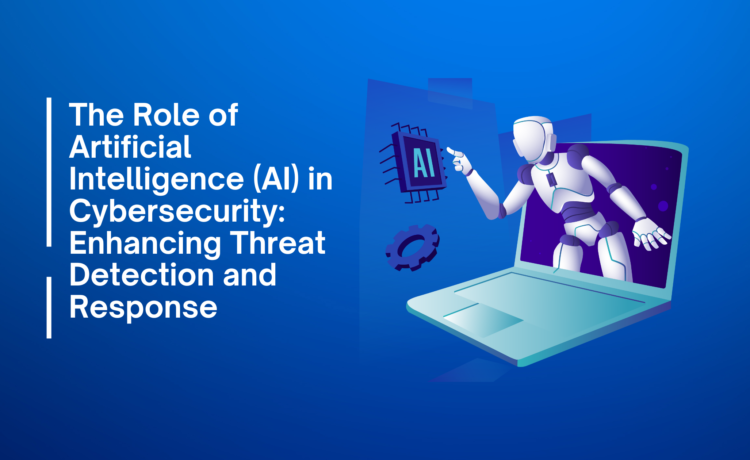Introduction to Artificial Intelligence and Cybersecurity
Artificial Intelligence (AI) and cybersecurity are among the most transformative fields in today’s digital landscape. As technology advances at an unprecedented pace, the sophistication of cyber threats has also grown. From complex malware to highly skilled hackers, both individuals and organizations are constantly challenged to protect their sensitive information and maintain robust security measures.
AI has emerged as a game-changer in cybersecurity, offering innovative solutions to combat evolving threats. Its capacity to analyze vast amounts of data, identify patterns, and make real-time decisions has revolutionized how we approach threat detection and response. This blog post delves into how AI enhances cybersecurity, its growing importance, and the myriad benefits it brings to organizations striving to secure their digital environments.
The Growing Need for AI in Cybersecurity
The accelerating pace of technological advancement has brought about significant changes in the cybersecurity landscape. Traditional security measures are increasingly inadequate against sophisticated cyber threats. This is where Artificial Intelligence (AI) comes into play.
AI’s ability to process and analyze massive amounts of data quickly and accurately is crucial in today’s complex cyber environment. Traditional methods often fall short due to their reliance on manual processes and limited scope. AI addresses these limitations by offering several key advantages:
- Enhanced Threat Detection: AI systems can continuously monitor networks, endpoints, and user behavior, quickly identifying anomalies that could indicate a potential threat. Unlike traditional methods, which rely on known attack signatures, AI uses machine learning to detect unusual patterns and behaviors that could signify a novel or zero-day attack.
- Automated Processes: AI automates routine tasks such as log analysis and vulnerability scanning, freeing up valuable time for security professionals to focus on more critical aspects of incident response. This automation not only increases efficiency but also reduces the risk of human error.
- Real-Time Response: AI can facilitate immediate responses to detected threats. For example, AI algorithms can automatically isolate affected devices, block suspicious IP addresses, or implement countermeasures without waiting for human intervention. This rapid response is vital in minimizing the damage from cyber attacks.
- Adaptability and Learning: AI-powered systems use machine learning to continuously improve their detection and response capabilities. As new threats emerge, these systems adapt by learning from historical data and evolving their algorithms to stay ahead of cybercriminals.
- 24/7 Monitoring: Unlike human analysts, AI systems do not require breaks or downtime. They can provide continuous monitoring and analysis, ensuring that potential threats are detected and addressed at any time of day.
How AI is Enhancing Threat Detection
In the dynamic field of cybersecurity, staying ahead of malicious threats is a continuous challenge. AI is transforming threat detection by offering advanced capabilities that surpass traditional methods:
- Anomaly Detection: Traditional security systems often rely on signature-based detection, which can be ineffective against new or unknown threats. AI excels in anomaly detection by analyzing historical data and identifying deviations from normal behavior. This capability allows AI to detect zero-day attacks and other novel threats that do not match known attack signatures.
- Predictive Analytics: AI’s predictive analytics capabilities enable proactive threat hunting. By analyzing historical attack patterns and user behavior, AI can forecast potential vulnerabilities and identify high-risk areas before they are exploited. This allows organizations to prioritize their resources and address potential threats proactively.
- Data Processing and Speed: AI systems can process vast amounts of data simultaneously, identifying subtle indicators of malicious activity that might be missed by human analysts. This high-speed data processing is essential for detecting threats in real-time, particularly in large and complex networks.
- Enhanced Accuracy: AI algorithms are designed to continuously learn from new data and past incidents. This iterative learning process improves the accuracy of threat detection, reducing the likelihood of false positives and false negatives. As a result, security teams can focus on genuine threats and respond more effectively.
- Integration with Existing Security Infrastructure: AI can be integrated with existing security systems to enhance their capabilities. For example, AI can analyze logs generated by traditional security tools, providing deeper insights and identifying patterns that might be overlooked by conventional methods.
Real-Time Response with AI
The ability to respond quickly to cyber threats is crucial in minimizing damage and mitigating potential risks. AI enhances real-time response capabilities through several key mechanisms:
- Immediate Threat Isolation: Once a threat is detected, AI systems can take immediate action to isolate affected devices or users from the network. This helps prevent the spread of the attack and limits its impact on other systems.
- Automated Incident Response: AI-powered systems can execute predefined response actions automatically. For example, they can block suspicious IP addresses, terminate compromised sessions, or quarantine affected files without requiring manual intervention. This automation accelerates the response process and reduces the time between detection and mitigation.
- Adaptive Responses: AI systems use machine learning to adapt their response strategies based on new information and evolving threats. This adaptive capability ensures that responses remain effective against emerging attack techniques and tactics.
- Scalability: As the number of connected devices and data sources grows, traditional security measures may struggle to keep up. AI systems can scale to handle increased workloads, ensuring that security measures remain effective even as network complexity and data volume increase.
- Reduction in False Positives: AI’s ability to analyze and learn from historical data helps reduce the number of false positive alerts. By distinguishing between legitimate threats and harmless activities, AI minimizes the need for manual investigation and allows security teams to focus on actual threats.
Advantages of Using AI in Cybersecurity
AI offers several significant advantages in the field of cybersecurity:
- Speed and Efficiency: AI systems can analyze and process data at speeds far beyond human capabilities. This rapid analysis enables timely threat detection and response, reducing the potential impact of cyber attacks.
- Continuous Learning and Improvement: AI algorithms improve their performance over time by learning from new data and past incidents. This continuous learning process enhances the accuracy of threat detection and response, keeping pace with evolving threats.
- Automation of Routine Tasks: AI automates repetitive tasks such as log analysis and vulnerability scanning, freeing up security professionals to focus on more complex and strategic activities.
- 24/7 Monitoring and Protection: AI systems provide continuous monitoring and protection, ensuring that potential threats are detected and addressed at any time of day. This constant vigilance is essential for maintaining robust security in a constantly evolving threat landscape.
- Advanced Threat Detection: AI’s ability to detect anomalies and predict potential threats allows organizations to identify and address risks before they escalate into serious incidents. This proactive approach enhances overall security and reduces the likelihood of successful attacks.
Challenges and Limitations of AI in Cybersecurity
While AI offers numerous benefits, it also presents several challenges and limitations:
- Vulnerability to Attacks: AI systems themselves can be targeted by cybercriminals. Hackers may exploit vulnerabilities within AI algorithms or manipulate data inputs to disrupt threat detection and response.
- Lack of Explainability: Some AI models, particularly deep learning algorithms, can be difficult to interpret. This lack of transparency makes it challenging for cybersecurity professionals to understand and trust the decisions made by AI systems.
- Privacy Concerns: AI-powered cybersecurity tools often collect large amounts of personal data. Ensuring that data protection measures are in place to prevent misuse or unauthorized access is crucial for maintaining privacy and compliance with regulations.
- Evolving Threats: The rapidly changing nature of cyber threats poses a challenge for AI systems. Hackers continuously adapt their techniques, requiring AI solutions to be regularly updated and improved to remain effective.
- False Positives and Negatives: AI systems may still generate false positives or false negatives in threat detection. False positives can lead to unnecessary alarms, while false negatives may result in undetected breaches. Balancing accuracy and efficiency is an ongoing challenge.
Future Possibilities and Innovations in the Field
The future of AI in cybersecurity holds exciting possibilities and innovations:
- Machine Learning for Emerging Threats: Advances in machine learning algorithms will enable AI to detect and respond to new and evolving threats more effectively. By analyzing vast amounts of data from diverse sources, AI can identify emerging patterns and vulnerabilities before they are exploited.
- Integration with Security Analytics Platforms: AI will continue to enhance security analytics platforms by providing real-time insights and adaptive threat detection capabilities. This integration will improve the accuracy and efficiency of threat detection and response.
- Natural Language Processing (NLP): NLP advancements will enable AI systems to better understand and analyze human communication patterns. This capability will improve the identification of phishing attempts, social engineering attacks, and other forms of malicious content.
- IoT Security: As the Internet of Things (IoT) expands, AI will play a crucial role in securing interconnected devices and networks. AI’s ability to monitor and analyze device behavior will help detect anomalies and prevent breaches in IoT environments.
- Human-AI Collaboration: Future innovations will focus on enhancing collaboration between human analysts and AI systems. By leveraging AI’s automation and data processing capabilities, security professionals can concentrate on strategic tasks and decision-making while AI handles routine activities.
Conclusion
Artificial Intelligence is rapidly transforming the field of cybersecurity, offering advanced capabilities that enhance threat detection and response. With its ability to analyze vast amounts of data, detect patterns, and make real-time decisions, AI is a powerful tool in the ongoing battle against cyber threats.
While AI presents significant advantages, including speed, accuracy, and automation, it also comes with challenges and limitations that must be addressed. The evolving nature of cyber threats and the need for transparency and privacy highlight the importance of ongoing research and development in AI-driven cybersecurity solutions.
Looking ahead, the integration of AI with security analytics platforms, advancements in machine learning and natural language processing, and improvements in IoT security will shape the future of cybersecurity. By embracing these innovations and addressing existing challenges, organizations can enhance their security posture and better protect themselves against the ever-growing array of cyber threats.





